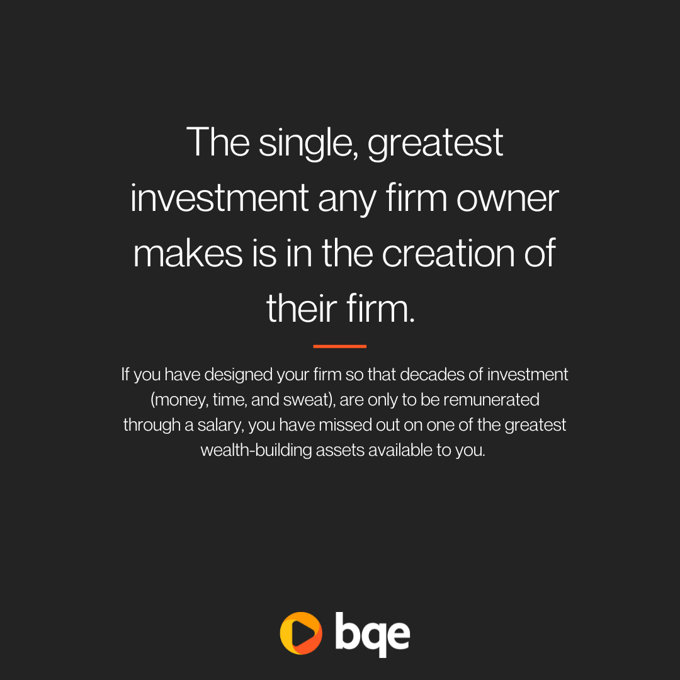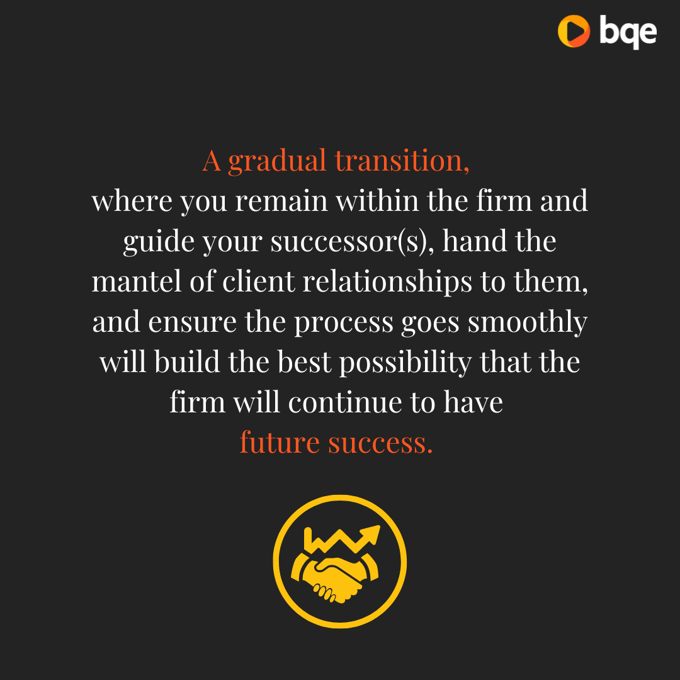Technological Darwinism: Why Engineers Need Modern Software To Survive
Engineering firms have a choice: adapt by adopting new software or get left behind by those who do.
To transition to retirement and ensure you leave behind a successful firm you want to have a plan in place to pass down to those behind you.
Our industry comprises mainly small firms with one or two principals, conceived as lifestyle businesses. There is nothing inherently wrong with this, but as you are about to see, this topic is often ignored in businesses of this type. You’ve worked hard to become a licensed professional. You’ve spent years training and interning before becoming licensed and eventually taking the leap to create your own business. You’ve earned the right to hang out your shingle and reap the rewards of selling your services directly to your clients. So, knowing how to transition to retirement is crucial.
According to a 2020 survey from the AIA, 91% of all firms have fewer than 19 employees. 60% of all architects work in firms with fewer than 10 employees. In other words, the profession truly is a small business. The principals of these businesses can enjoy decades of professional and financial fulfillment through their firm: cultivating clients, building a team of professionals that represents the culture they envision, and creating projects that fulfill their design aspirations. This is all great news, or so it seems.
Small business owners often reach a point in their careers where they start wondering, "What's next?"
Most design professionals genuinely enjoy their work and can't imagine retiring. Very often, they don’t hit their stride and become masters of their craft until later in life, the point when others are starting their retirement journey. Unfortunately, by the time these small-business professionals consider their future options, it's often too late to maximize the benefits.
Let's draw a parallel with the advice we receive from a financial advisor.
The earlier you start saving for retirement, investing in a 401K or a similar retirement account, the greater the rewards will be when you eventually retire. This is mostly due to the power of compound interest. I'm sure many of you reading this can agree with that. If you set up automatic payments from each paycheck to fund your retirement account, you will have a respectable nest egg by the time you reach old age.
This is a key to your ability to live a quality life during a time when you may be receiving a fixed income. The purpose of a retirement account is to provide for your future needs when you don’t work. I expect that nearly all of you are doing this, even though you don’t think you’re the type of person who will retire. As someone over the age of 65, my own retirement account began over 40 years ago, when retiring was a laughable concept. It was a great decision to take the advice of a financial advisor and commit to contributing to a few IRAs and later a 401K with small increments from each paycheck.
When you have money to invest, there are many options open to you. Anything you invest in, like the stock market, bonds, real estate, crypto, precious metals, annuities, CDs, high-yield savings accounts, index funds, etc. These are investments that are out of your control. You’re really just going along for the ride.

If you’re lucky, over the long term, that investment will return 8%, accounting for inflation and reinvestment of dividends. And yes, you don’t need to think about it. Your money is working for you while you sleep.
And, while I believe everyone should have diversified investments, if you’re smart, ambitious, hard-working, and willing to put in the effort, there is no better investment than your own business.
According to the US Bureau of Labor Statistics, 50% of small businesses fail within 5 years, and 70% fail within 10 years. I’ll wager that you are in the top 30% of your class, and the firm you build will defy those odds.
The single greatest investment any firm owner makes is in the creation of their firm. If you have designed your firm so that decades of investment (money, time, and sweat) are only to be remunerated through a salary, you have missed out on one of the greatest wealth-building assets available to you.
Most people are familiar with the investment potential of real estate. It’s often seen as the best path to wealth. For many, this is represented in their home.
If you purchased an average home in a suburb of New York City, 30 years ago (with a 20% down payment and a fixed-rate mortgage of about 6%), you would have experienced a compound annual growth rate (CAGR) of ~3.5%. If you put that downpayment in a mutual fund with the S&P 500, you would have a CAGR of ~10%. Of course, real estate has other benefits, such as shelter and tax benefits. However, that same downpayment invested in your firm could yield a CAGR of ~20% on average.
If you recognized that the firm you created is simultaneously the single biggest investment opportunity (bringing you the greatest potential for future wealth), you would have considered your exit strategy.
In other words, you would have planned how you transition from being an active participant in the firm to benefiting from all that hard work that you invested in it over the decades, long after you stop being active.
Hopefully, you would have discussed with your attorney at the time when you were setting up the business, about how you would handle the ownership transition. How to bring in new owners (principals or partners), and how to determine the firm’s valuation. If this were not a discussion, I’d like you to consider hiring a new attorney.
The firm is not merely a vehicle to allow you to practice your profession. Your profession is the vehicle that enabled you to create a business. You may not realize this, but a business is actually about value creation. While you’re enjoying the profession and practicing your craft, if you’re conducting business properly, your firm is simultaneously creating incredible value: value that is enjoyed by your clients, your employees, your vendors, and you.
If all that value disappears when you retire, it’s like forfeiting your 401K when you stop working rather than reaping the benefit of decades of investment.
Very few people succeed in creating a sustainable business. This is why the public perception is that retirement accounts (IRAs and 401Ks), and real estate are the big future wealth investment vehicles. However, you have a successful business, so you have beaten the odds already.
When thinking about your business, you must recognize that it has much greater potential than just allowing you to live a particular lifestyle. It can allow you to do what you can’t imagine. And if your needs are simple, think about how much good you could create elsewhere in the world with all that value you have the potential to create through your business!
I have met countless A/E professionals who are at the prime of their careers and are sole proprietors. They built a small team and are making a great living. They don’t see a reason to change anything. It’s working great! They believe this can go on forever.
Unfortunately, it’s usually the departure of a key figure in the firm that shakes them out of this fantasy. The disruption of operations, the loss of client relationships, and the degradation of firm morale are often the knock-on effects when this happens. Only then do these owners realize the need to consider the future needs of their staff.
Please, regardless of how wonderful your firm is operating today, if you don’t have a succession plan, a plan to transition to retirement, you are sitting on a ticking bomb.
Hopefully, you have come around to recognizing that in your transition to retirement, you must prepare for succession. Next, you need to consider the options. If you built a strong firm and the market conditions are right, you can consider an M&A event. But you have no control over the timing or the economy. The best place to start is by nurturing future owners within the firm.

Implement a mentoring plan in the firm and recruit new employees who have the talent and skills you desire but also have aspirations of ownership. Don’t feel threatened. You are their golden ticket and control the narrative.
There are several options for how the transition to retirement can work. A gradual transition, where you remain within the firm and guide your successor(s), hand the mantel of client relationships to them, and ensure the process goes smoothly, will build the best possibility that the firm will continue to have future success.
If you exit suddenly, so much goodwill with your clients will be lost, and the valuation of the firm will suffer a considerable discount.
Don’t put any plan in place without discussing it with your attorney and financial advisor. But-sell agreements, valuation methods, retirement income, etc., need to be considered for legal and tax ramifications.
During the transition to retirement, it will be important to maintain the firm’s culture and values. When you sell to key employees, this has the greatest likelihood of being successful. If you are considering a merger or acquisition, you will have an enormous task and responsibility to ensure the successor is a good fit culturally and aligns with the firm’s values. If not, there will be a lot of avoidable misery for these people who stay on with the firm, and your exit strategy may be tied to future income (earn-out). If the culture isn’t maintained, it can have a negative impact on work and revenue.
If you own a firm, you are sitting on a potential gold mine. While it provides you with a great lifestyle today, it can provide you with an enormous windfall in the future. Don’t only do great work for your clients. Recognize that business is about building value IN the business. When you appreciate this notion, other people will want to buy that value. This is when your firm transitions from a great place where you practice your profession to becoming the golden ticket that allows you to do greater things than merely provide professional services to your clients.
To learn more firm management tips and how to ensure your business is set up for success, visit BQE University for a library of thought leader articles, webinars, eBooks, and more.
Steven Burns, FAIA, is a renowned global thought leader, architect, and highly sought-after speaker on topics related to emerging technologies and effective firm management. As the founder of The Well-Designed Firm, a cutting-edge business consultancy, Steven is committed to helping A/E firms elevate their business practices to the same level of elegance as the architecture they create. With a Master of Architecture degree from the prestigious Harvard Graduate School of Design and over 7 years of experience at SOM, Steven is a true expert in his field. He also founded his own architecture firm, BBA Architects, which he successfully sold in 2007. Steven's contributions to the architecture industry go beyond his work as an architect and business consultant. He is also the mastermind behind ArchiOffice, a popular project and office management software that he developed and later sold to BQE Software in 2010.
Engineering firms have a choice: adapt by adopting new software or get left behind by those who do.
Big Risk for Bigger Reward in Small Architecture Firms, Part 1 - BQE Software
From executive summary to exit strategy, Steven Burns FAIA guides you on how to write a business plan for architects.
Be the first to know the latest insights from experts in your industry to help you master project management and deliver projects that yield delighted clients and predictable profits.